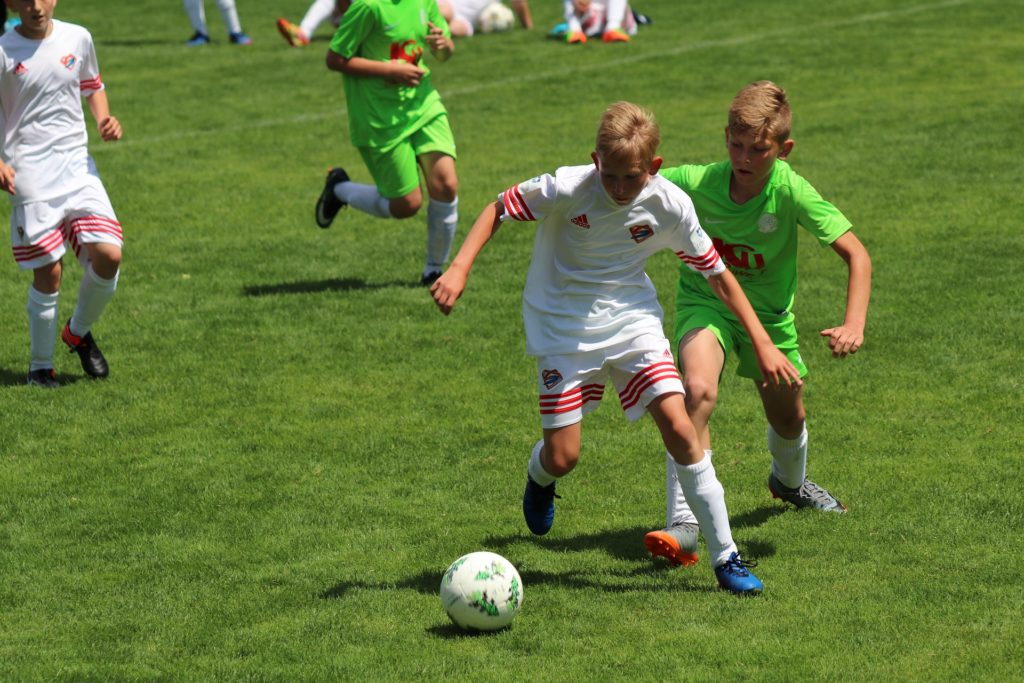To look at the skills you must develop at U8, click here
Receiving on the Back Foot/Half Turn

By U10, players are becoming more naturally inclined to pass the ball as opposed to going alone. This is down to both the social and cognitive natures of the age group. Children also have increased foot-eye coordination skills, meaning that being able to receive the ball without simply stopping it becomes far more achieveable.
At U10, children are able to see more than one side of a situation. While this will happen at different times based on the child, from a football stand point it means that they can understand there is more than one way to move the ball forward. This lends itself to greater problem-solving skills, needed with the increase of players on the pitch at 7 v 7. Players are required to consider how to create space for themselves and pushing the ball in one direction or another will allow them to do this.
Receiving on the half-turn gives players a greater viewpoint of the pitch and the space, team mates and opponents' that are around them. U10's can understand more complex instructions. They are capable of being able to turn their body, let the ball travel across them, check their shoulders and make a decision based on what they see all in the space of a second. Of course this takes practice.
The activity Check your Shoulders is a great introduction to teaching this skill.
Aerial Control

Hands up if you've ever said, or heard "don't let it bounce!"? For a young player, this isn't an easy thing to do. For starters, they have a round leather case travelling towards their face, getting bigger and faster as it drops out of the air. Secondly, it requires a lot of coordination to connect with the ball effectively. In some countries, heading is even banned until U11, meaning one option of "not letting it bounce" cannot be used.
As already mentioned, children have developed better coordination by U10. Coupled with this is an improvement in their strength levels. When we combine these 2 physical traits, it means we can teach them ways to to control an aerial ball that allows for success and safety.
The thigh muscles are the biggest in the body. The thigh is also closer to the eyes than the feet. Before all else we should be developing this area of aerial ball control. After this, we can develop progress down to the body to the feet. We do this by setting challenges to juggle the ball, or by using games such as Circle Warm Up, which helps build confidence to attempt this type of control in games.
Defending 1 v 1

Defending takes a lot of patience and discipline. While some U8 players will have this, my experience has shown that many don't. Even on a trip to Ajax's De Toekomst facility, I was informed that their U8's defensive coaching simply consisted of "get the ball back as fast as you can". To go through the motions of defending in a 1 v 1 situation really doesn't suit the needs of that age group.
1 v 1 defending means the following 4 things are required
Close down - pressure the ball
Slow down - on approach to the player in possession
Low down - bend knees to be able to jockey the opponent
Show down - side on to force them in the direction you want them to go
The first 2 elements - close down and slow down - require speed management, something that is not prevelant in many at U8. Players younger than U9-10 generally move at 2 speeds - all out sprint or extremely slow - with levels in between still being learned. 1 v 1 defending requires this knowledge of being able to manage speeds, otherwise the opponent has a much greater chance of taking the ball right past them.
Help your players 1 v 1 defending with the game Defend the Penalty Area.


Love the content
A good guide indeed… especially on the defense part…if possible kindly send me or advise me where to find the skills online ..thank you
Thank you. Our free drills section has activities that can be used to develop them. Alternatively, our members library database has tons more activities that go into more detail.